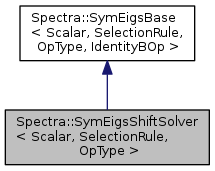#include <SymEigsShiftSolver.h>

Public Member Functions | |
| SymEigsShiftSolver (OpType *op, Index nev, Index ncv, Scalar sigma) | |
 Public Member Functions inherited from Spectra::SymEigsBase< Scalar, SelectionRule, OpType, IdentityBOp > Public Member Functions inherited from Spectra::SymEigsBase< Scalar, SelectionRule, OpType, IdentityBOp > | |
| Index | compute (Index maxit=1000, Scalar tol=1e-10, int sort_rule=LARGEST_ALGE) |
| Vector | eigenvalues () const |
| virtual Matrix | eigenvectors (Index nvec) const |
| virtual Matrix | eigenvectors () const |
| int | info () const |
| void | init (const Scalar *init_resid) |
| void | init () |
| Index | num_iterations () const |
| Index | num_operations () const |
Private Types | |
| typedef Eigen::Array< Scalar, Eigen::Dynamic, 1 > | Array |
| typedef Eigen::Index | Index |
Private Member Functions | |
| void | sort_ritzpair (int sort_rule) |
Private Attributes | |
| const Scalar | m_sigma |
Additional Inherited Members | |
 Protected Attributes inherited from Spectra::SymEigsBase< Scalar, SelectionRule, OpType, IdentityBOp > Protected Attributes inherited from Spectra::SymEigsBase< Scalar, SelectionRule, OpType, IdentityBOp > | |
| LanczosFac | m_fac |
| const Index | m_n |
| const Index | m_ncv |
| const Index | m_nev |
| Index | m_niter |
| Index | m_nmatop |
| OpType * | m_op |
| Vector | m_ritz_val |
Detailed Description
template<typename Scalar = double, int SelectionRule = LARGEST_MAGN, typename OpType = DenseSymShiftSolve<double>>
class Spectra::SymEigsShiftSolver< Scalar, SelectionRule, OpType >
This class implements the eigen solver for real symmetric matrices using the shift-and-invert mode. The background information of the symmetric eigen solver is documented in the SymEigsSolver class. Here we focus on explaining the shift-and-invert mode.
The shift-and-invert mode is based on the following fact: If  and
and  are a pair of eigenvalue and eigenvector of matrix
are a pair of eigenvalue and eigenvector of matrix  , such that
, such that  , then for any
, then for any  , we have
, we have
![\[(A-\sigma I)^{-1}x=\nu x\]](form_354.png)
where
![\[\nu=\frac{1}{\lambda-\sigma}\]](form_355.png)
which indicates that  is an eigenpair of the matrix
is an eigenpair of the matrix  .
.
Therefore, if we pass the matrix operation  (rather than
(rather than  ) to the eigen solver, then we would get the desired values of
) to the eigen solver, then we would get the desired values of  , and
, and  can also be easily obtained by noting that
can also be easily obtained by noting that  .
.
The reason why we need this type of manipulation is that the algorithm of Spectra (and also ARPACK) is good at finding eigenvalues with large magnitude, but may fail in looking for eigenvalues that are close to zero. However, if we really need them, we can set  , find the largest eigenvalues of
, find the largest eigenvalues of  , and then transform back to
, and then transform back to  , since in this case largest values of
, since in this case largest values of  implies smallest values of
implies smallest values of  .
.
To summarize, in the shift-and-invert mode, the selection rule will apply to  rather than
rather than  . So a selection rule of
. So a selection rule of LARGEST_MAGN combined with shift  will find eigenvalues of
will find eigenvalues of  that are closest to
that are closest to  . But note that the eigenvalues() method will always return the eigenvalues in the original problem (i.e., returning
. But note that the eigenvalues() method will always return the eigenvalues in the original problem (i.e., returning  rather than
rather than  ), and eigenvectors are the same for both the original problem and the shifted-and-inverted problem.
), and eigenvectors are the same for both the original problem and the shifted-and-inverted problem.
- Template Parameters
-
Scalar The element type of the matrix. Currently supported types are float,doubleandlong double.SelectionRule An enumeration value indicating the selection rule of the shifted-and-inverted eigenvalues. The full list of enumeration values can be found in Enumerations. OpType The name of the matrix operation class. Users could either use the wrapper classes such as DenseSymShiftSolve and SparseSymShiftSolve, or define their own that implements all the public member functions as in DenseSymShiftSolve.
Below is an example that illustrates the use of the shift-and-invert mode:
Also an example for user-supplied matrix shift-solve operation class:
Definition at line 158 of file SymEigsShiftSolver.h.
Member Typedef Documentation
|
private |
Definition at line 162 of file SymEigsShiftSolver.h.
|
private |
Definition at line 161 of file SymEigsShiftSolver.h.
Constructor & Destructor Documentation
|
inline |
Constructor to create a eigen solver object using the shift-and-invert mode.
- Parameters
-
op Pointer to the matrix operation object, which should implement the shift-solve operation of  : calculating
: calculating  for any vector
for any vector  . Users could either create the object from the wrapper class such as DenseSymShiftSolve, or define their own that implements all the public member functions as in DenseSymShiftSolve.
. Users could either create the object from the wrapper class such as DenseSymShiftSolve, or define their own that implements all the public member functions as in DenseSymShiftSolve. nev Number of eigenvalues requested. This should satisfy  , where
, where  is the size of matrix.
is the size of matrix. ncv Parameter that controls the convergence speed of the algorithm. Typically a larger ncv_means faster convergence, but it may also result in greater memory use and more matrix operations in each iteration. This parameter must satisfy , and is advised to take
, and is advised to take  .
. sigma The value of the shift.
Definition at line 193 of file SymEigsShiftSolver.h.
Member Function Documentation
|
inlineprivatevirtual |
Reimplemented from Spectra::SymEigsBase< Scalar, SelectionRule, OpType, IdentityBOp >.
Definition at line 167 of file SymEigsShiftSolver.h.
Member Data Documentation
|
private |
Definition at line 164 of file SymEigsShiftSolver.h.
The documentation for this class was generated from the following file: